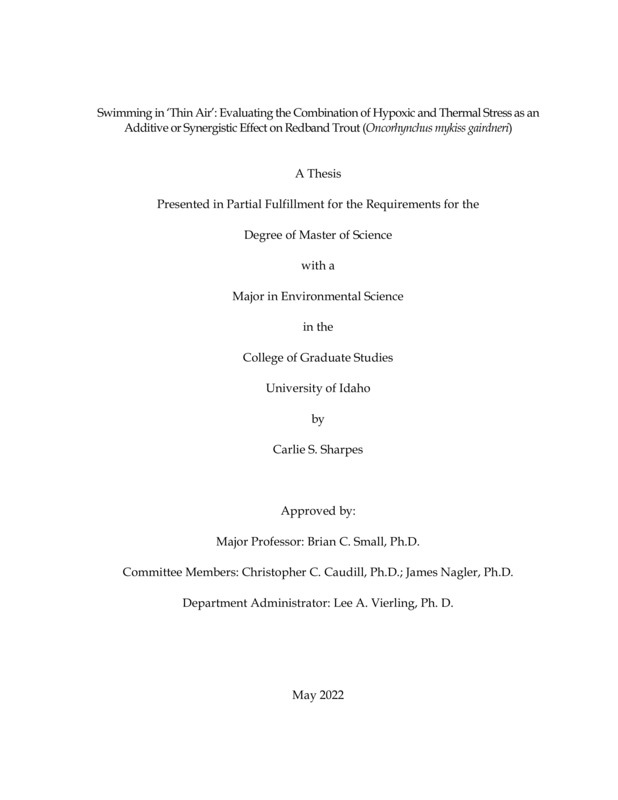Swimming in 'thin air': Evaluating the combination of hypoxic and thermal stress as an additive or a synergistic effect on Redband Trout (Oncorhynchus mykiss gairdneri)
Sharpes, Carlie S. (2022-05). Swimming in 'thin air': Evaluating the combination of hypoxic and thermal stress as an additive or a synergistic effect on Redband Trout (Oncorhynchus mykiss gairdneri). Theses and Dissertations Collection, University of Idaho Library Digital Collections. https://www.lib.uidaho.edu/digital/etd/items/sharpes_idaho_0089n_12260.html
- Title:
- Swimming in 'thin air': Evaluating the combination of hypoxic and thermal stress as an additive or a synergistic effect on Redband Trout (Oncorhynchus mykiss gairdneri)
- Author:
- Sharpes, Carlie S
- Date:
- 2022-05
- Keywords:
- acute thermal stress cardiac function common garden hypoxia phenotypic plasticity vulnerability
- Program:
- Environmental Science
- Subject Category:
- Biology; Wildlife conservation; Physiology
- Abstract:
-
Climate warming causes both increases in extreme environmental water temperature and decreased dissolved oxygen (DO) concentrations (hypoxia) that induce stress in salmonid fishes including trout. Redband trout (Oncorhynchus mykiss gairdneri) have divergent ecotypes corresponding to a diverse range of thermal conditions from warm desert to cold montane ecosystems. Additionally, trout can alter their physiological phenotype to acclimate to environmental stressors. I predicted that warm acclimation would increase thermal tolerance, increase cardiac performance, and decrease hypoxia tolerance relative to the cooler acclimation temperature. Further, I anticipated that the impact of hypoxic and thermal stress would be lowest for the desert ecotype. The combination of hypoxia and acute temperature increase stress was postulated to have a synergistic effect on trout performance. Trout were collected from wild populations and acclimated to 21°C (near upper pejus temperature) and 15°C (within thermal optimum range) to model the desert and cold montane habitats, respectively, using two metric units. First, the time at loss of equilibrium (LOE) was recorded as a proxy for hypoxia tolerance where DO was decreased to ~12% saturation in an experimental tank. Second, cardiac phenotypic response, quantified by heart rate (ƒH), measured using an electrocardiogram (ECG) during acute temperature increase with 50% DO saturation (hypoxia) or full DO saturation (normoxia). Warm acclimated trout had significantly shorter time to LOE, and thus inferior hypoxia tolerance relative to the cold- acclimated trout (p ≤ 0.001). A significant interaction between ecotype and acclimation temperature took place at the 21°C acclimation temperature where the cool montane ecotype had significantly shorter time to LOE relative to the desert ecotype (p ≤ 0.05). Warm acclimated fish exhibited a significantly higher temperature at peak heart rate (Tpeak), and thus a superior thermal tolerance than cold-acclimated trout (p ≤ 0.001). As expected, the Tpeak was significantly greater for trout subjected to normoxia rather than hypoxia (p ≤ 0.05). No significant difference was detected for Tpeak response between ecotypes. The warm-acclimated trout displayed significantly lower ƒH at temperature increments 15-20°C (p ≤ 0.001) and 21- 22°C (p ≤ 0.05) relative to the cold- acclimated trout. Greater ƒH values indicate greater bioenergetic cost. As Tpeak increased with warm acclimation temperature, ƒH had decreased, indicating that thermal tolerance can vary inversely with cardiac performance. The ƒH values with both hypoxic and thermal stressors combined were not greater than the sum of ƒH for each isolated stressor, thus the combination of hypoxic and thermal stress was seen to have an additive rather than synergistic effect on trout performance.
- Description:
- masters, M.S., Environmental Science -- University of Idaho - College of Graduate Studies, 2022-05
- Major Professor:
- Small, Brian C
- Committee:
- Caudill, Christopher; Nagler, James J; Vierling, Lee
- Defense Date:
- 2022-05
- Identifier:
- Sharpes_idaho_0089N_12260
- Type:
- Text
- Format Original:
- Format:
- application/pdf
- Rights:
- In Copyright - Educational Use Permitted. For more information, please contact University of Idaho Library Special Collections and Archives Department at libspec@uidaho.edu.
- Standardized Rights:
- http://rightsstatements.org/vocab/InC-EDU/1.0/

